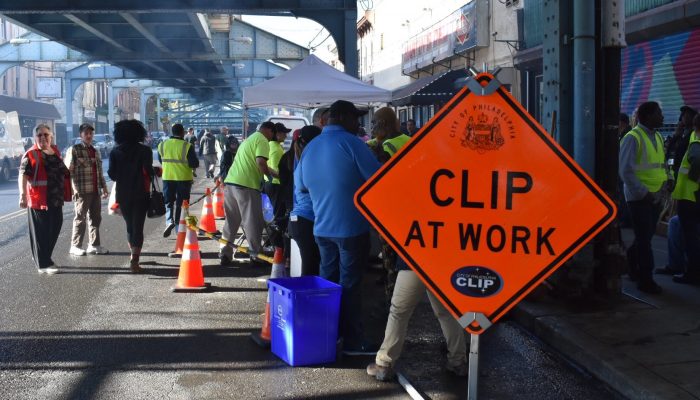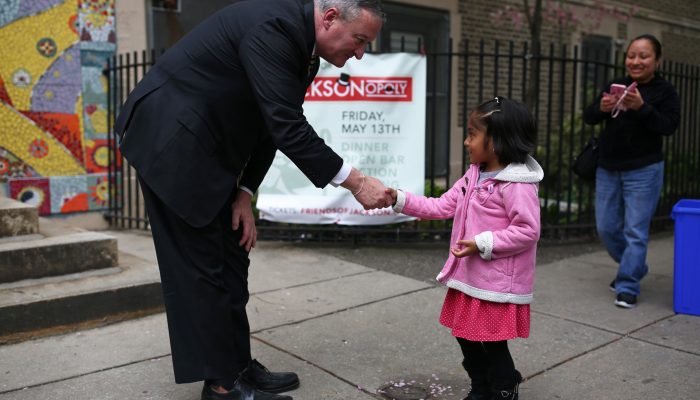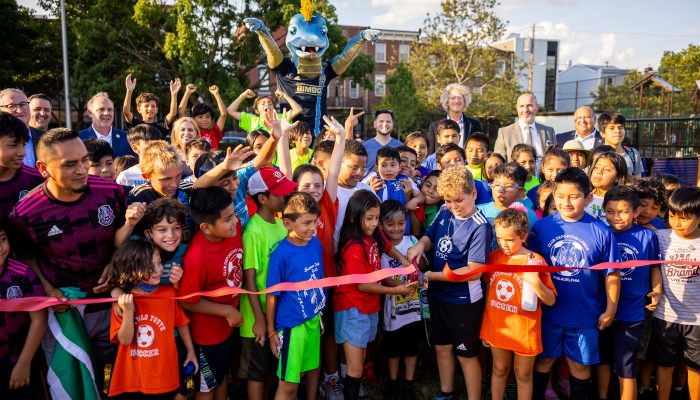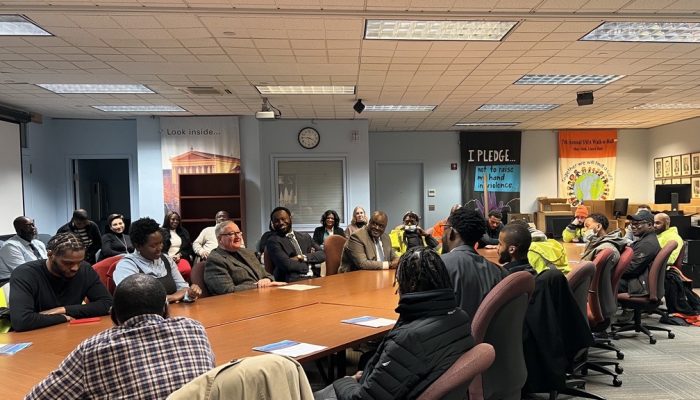Every week, we report on the Philadelphia Resilience Project, the City’s emergency response to combat the opioid crisis. Right now, the efforts are focused on Kensington and surrounding neighborhoods – the epicenter of the opioid crisis – but we expect to expand to other sections of the city as needed.
This week, we’re reporting on the status of all of the immediate goals, which have a deadline of November 16, 2018.
| Mission Area 1: Clear Encampments | |
| Immediate Goal | Progress as of November 16, 2018 |
| Clear Frankford Avenue encampment of all campers and debris by November 15. | Complete. |
| In coordination with Mission Areas 3 and 6, solidify housing plans for 100 percent of Frankford encampment individuals who are relocated to the Navigation Center within 30 days of intake. | In progress. |
| Prevent unsafe squatting and the formation of new encampments on all vacant properties within the target area by November 15. | In progress. We are continuing to complete block-by-block surveys, and mapping is being updated to inform strategy. Vacant lot owners were notified of the threat of encampments and reminded of their rights and responsibilities for vacant lots.
|
| Mission Area 2: Reduce Criminal Activity | |
| Immediate Goal | Progress as of November 16, 2018 |
| Reduce injection drug use. Cut down demand for drugs. | In progress. We are organizing an outreach team to be escorted by Police to begin work along the Kensington Ave. corridor between Thanksgiving and Christmas. |
| Create and strengthen existing safe corridor routes for travel to and from school. | In progress. Elkins and Willard Schools Safe Corridors routes to be implemented week of Nov. 26. With plans to expand program to all schools in the area. |
| Increase safety measures for children using foot and bike patrols, plus daily school checks. | In progress. Four police officers have been dedicated specifically to designated schools Mon-Fri, with specific service detail staff dedicated to all schools in the 25th, 25th, and 26th districts.
Police also increased its presence during Trick or Treat and hosted several community events during Halloween week. There were no reported incidents on Halloween. |
| Implement Police-Assisted Diversion (PAD) program in East Police Division. | Complete. The PAD program expanded to the East division on November 15. PAD is a harm reduction based approach giving police an alternative to arrest and prosecution. Through PAD, police officers are able to redirect low-level offenders engaged in drug or other activity to community-based services. |
| Support the operation of removing the encampment on November 15. | Complete. The Police Department has devoted resources to support this effort. |
| Mission 3: Reduce Unsheltered Population | |
| Immediate Goal | Progress as of November 16, 2018 |
| Identify a temporary site for a 24-hour Navigation Center including respite and wrap-around services | In progress. Potential sites have been assessed, but no site has been confirmed. |
| Create a budget and determine the cost to stand up a Navigation Center. | Complete. A budget for a Navigation Center has been created and submitted for approval. |
| Create a by-name list of unsheltered persons in the area and redeploy community outreach resources to ensure
that the mission area is reaching as much of the target population as possible. |
In progress. There is currently a by-name list for Frankford and Emerald encampments. A by-name list for the Kensington area is in development. |
| Develop a strategy to bring in public and health services. | In progress. A budget proposal for a Navigation Center with wrap around services has been developed and is awaiting Finance review.
Several organizations met with OHS on November 15 to discuss the provision of services focusing on the needs of those actively using in the Kensington community-at-large, incorporating housing options into the program. |
| Identify a provider to operate the Short-term Navigation Center | Complete. A provider (Self, Inc.) with a positive track record of operating large- scale shelters has been identified. We are working with that provider to expand treatment options and programs. |
| Mission 4: Reduce Trash and Litter | |
| Immediate Goal | Progress as of November 16, 2018 |
| Conduct a large scale clean-up along Kensington Ave on November 2. | Complete. A large-scale cleanup was held on November 1. Ongoing cleanups will continue along the same Kensington corridor as the large-scale cleanup. Smaller scale clean-up efforts are ongoing and the next one is scheduled for December 8. |
| Place needle drop boxes at McPherson Square and targeted SEPTA stations. | Complete. Seven needle drop boxes were installed on October 25. |
| Provide a temporary dumpster to support Frankford Avenue encampment closure. | Complete. A dumpster was placed near the Emerald Street encampment. |
| Recruit volunteers with lived experience to assist with regular clean ups. | Complete. Seven participants of Center for Employment Opportunities (a workforce development organization) are cleaning with CLIP three days a week. |
| Use bicycles for mobile collection of discarded syringes. | Complete. A group called KIND (Kensington Initiative on Needle Disposal) is up and running. |
| 311 will establish a local informational and complaint line (pod) specifically for this operation. | Complete. The bilingual 311 pod is operational as of October 26 and is receiving approximately 50 calls a day. |
| Mission 5: Reduce Overdoses | |
| Immediate Goal | Progress as of November 16, 2018 |
| Prevent outbreak of Hepatitis A among homeless individuals and injection drug users in the Kensington area. | In progress. Outreach teams have been vaccinating in Kensington weekly. Focus has been in encampments and for those experiencing homelessness. Hepatitis A immunization of homeless and injection drug using populations has been implemented by street-side outreach. To date, 268 people have been immunized. Surveillance for cases of acute hepatitis A in Kensington has been implemented. There have been no cases of hepatitis A identified in the area. |
| Prevent transmission of HIV infection through injection drug use. | In progress. All service agencies and healthcare providers in Kensington area have been asked to increase HIV screening activities among drug users by at least 25% and HIV testing sites in Kensington have increased the number of tests performed by 31%. HIV surveillance data reports are distributed biweekly to key partners. 91% of injection drug users with new HIV infection were linked to medical care within 30 days. |
| Create risk-based model for identifying individuals who have experienced previous overdose and are at highest risk for a subsequent overdose so they can be referred for services. | In progress. It is in development and dependent on the establishment of a data-sharing agreement (outlined below). |
| Implement name-based data sharing and/or reporting of non-fatal overdoses and opioid-related risk conditions, so that highest-risk individuals can be referred for services by November 16. | In progress. A data-sharing agreement has been drafted and is under review by Law Department. Meetings to discuss data-sharing across City departments and the creation of a high-risk client list are occurring weekly with all relevant partners. Public Health has been tasked with being the “manager” of the high-risk client list, but access is granted to those providing services. |
| Mission 6: Increase Treatment Options and Access | |
| Immediate Goal | Progress as of November 16, 2018 |
| Disseminate information on treatment access. | In progress. CBH Member Services was present at ten events and an “Accessing treatment and a MAT Provider List” has been published to the DBHIDS website at dbhids.org/MAT. CBH Member Services and two CPS from DBHIDS are onsite weekly on Wednesdays at the Mural Arts Storefront in Kensington. CBH Member Services will be training 311 staff on accessing treatment and CBH Member Services as a resource from 11/28-12/5/2018. |
| Deploy mobile outreach team including medical professionals to provide Medication-Assisted Treatment (MAT) in the field. | In progress. In the first three weeks of The Resilience Project, Prevention Point Philadelphia’s Mobile Engagement Unit saw 24 individuals for wound care and initiated 10 individuals on MAT. In addition, multiple mobile outreach teams (JOH, Pathways, ODAAT, Gaudenzia), MAT providers (NET, Wedge, PPP, Merakey) and medical care professionals (PHMC, Jefferson) were at the encampments engaging individuals around treatment and providing wound care. |
| Coordinate with Community Forgiveness and Restoration Program at Temple. | Complete. 24 individuals attended the second workshop on 11/3/2018 with CBH Member Services and other resources/programs onsite (an increase from 21 individuals at the first workshop). |
| Facilitate access to treatment from bridges with reserved Kirkbride beds. | Complete. All five Kirkbride beds reserved for individuals who left the encampment have been occupied as of November 1. |
| Launch treatment capacity database. | In progress and being moved to a short-term goal. Final drafts are being refined for live posting. There will be a soft launch prior to live posting to ensure consistent and accurate reporting. |
| Expand warm hand-offs for treatment access across the system by December 31. | In progress and remains a short term goal. As of November 3, 142 warm handoffs to behavioral health treatment were accomplished. Alternate funding options are also being explored. |
| Mission 7: Mobilize Community Response | |
| Immediate Goal | Progress as of November 16, 2018 |
| Create a community calendar to highlight meetings, trainings, clean ups, big public events, paint days, and other programming. | Complete. The community calendar is live and publicly available at phila.gov/opioids. |
| Identify potential funding partners and engage an external fundraiser. | In progress. A RFP was issued for a consultant to develop a fundraising and partnership plan with philanthropy and private funders. Deadline for submissions was November 15. |
| Create and train Philly311 unit for specialized Kensington/Fairhill information and assignments. | Complete. Kensington’s 311 pod is operational as of October 26 and is operating in both English and Spanish. We’re receiving approximately 50 constituent calls a day, which are shared with serving departments daily. |
| Direct engagement with Kensington/Fairhill community. | In progress and ongoing. Community engagement continues through partnering with residents and local community leaders on beautification projects, participating in community meetings, and other events. A large community meeting with representatives of local community-based organizations and faith-based organizations was held on November 16. |
| Create a volunteer sign up form. | This is complete as of October 26 and can be accessed HERE. We are currently recruiting volunteers for upcoming cleanups. |
| Create targeted information and resources for neighborhood leaders. | In progress and ongoing. |
| Create promotional materials to share at libraries, rec centers, schools, and throughout the community. | In progress and ongoing. |
| Ensure all materials are understandable and meet other Access and Functional Needs (AFN) requirements. | In progress and ongoing. |
| Increase frequency of communication to residents providing status of the Philadelphia Resilience Project. | In progress. Weekly emails continue and we are determining which other targeted methods of communication will be deployed, such as texts, calls, canvassing, and community bulletins in neighborhood papers. |




